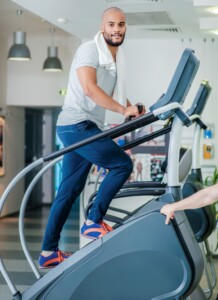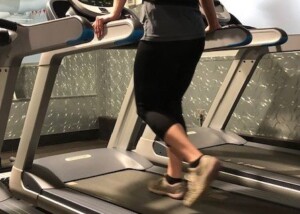
So which workout is better, the revolving staircase or an actual staircase?
Wow, this is a real interesting question to answer, but as a former personal trainer for a health club, I will happily address it.
Revolving Staircase vs. Real Staircase Workouts
The vast majority of those who use the revolving machine find the rails and console very convenient—as crutches to absorb some of the workload, making the exercise easier.
They will see this as a pro or benefit. I see it as an opportunity to encourage cheating and a false sense of accomplishment.
So what I’m going to do is compare the revolving staircase to a real set of stairs—with the idea that the exerciser is not holding onto the rails or draping their body all over the console.
Revolving Staircase Pros
• Promotes sticking to an intense rate of movement, as the trainee will be encouraged to finish out a given time lapse, with the seconds ticking right before them.
• Allows for accurate monitoring or tracking of time passage.
• Has various programs that encourage finishing out the routine.
• Perhaps the biggest benefit is that it’s not as tempting to just stop dead in one’s tracks.
Revolving Staircase Cons
• Well, I guess I have to bring it up again, because it’s such a glaring disadvantage: It is just way too tempting to hold onto the machine.
• The machine invites very crummy posture when you hold on: hunching way over, butt sticking way out, sometimes to the point where the exerciser’s back is nearly parallel to the floor.
• The more distorted the posture, the further away is the simulation of working out on a real staircase.
• The machine makes it impossible to effectively leap the steps.
The winner is a real staircase.
• There’s nothing to hold onto; cheating is impossible. It’s not likely the exerciser is going to grab ahold of the railing as they go up the steps.

Freepik.com
• All sorts of motions are possible: fast leaps and bounds; bunny hopping (though that’s actually possible on the revolving unit); sideways movement (that, too, is possible on the revolving unit—but how many people who do this also grip the rails?
Walking sideways on the revolving machine without holding on is very possible, but few people will let go).
• Walking up backwards is also more efficient when done on a real staircase, because, again, the real staircase encourages a hands free workout.
• Though a punishing HIIT routine can be done on the revolving machine, HIIT is even more fearsome on a real staircase.
• You can work out on real steps while holding dumbbells; the weights can be easily set down at varying points and then retrieved.
• A real staircase includes the component of going back down the steps, and this eccentric action on the knee joint will strengthen the knees and enhance coordination.
A real staircase, though, has one huge disadvantage: It is so easy to dead stop in the middle of the workout and just bend over, immobilized while catching one’s breath.
A second disadvantage is the availability of one. For many people, there just isn’t one around.
Those who live or work in a multi-story building are in luck, and those who live near a building structure with a lot of outdoor steps are also in luck.
Even though there are clear pros and cons when comparing the revolving staircase to a real one, there is one sure thing:
A workout using either venue can be a delightfully grueling experience! I recommend using both modes, if available, rather than just sticking to one.
 Lorra Garrick is a former personal trainer certified through the American Council on Exercise. At Bally Total Fitness she trained women and men of all ages for fat loss, muscle building, fitness and improved health.
Lorra Garrick is a former personal trainer certified through the American Council on Exercise. At Bally Total Fitness she trained women and men of all ages for fat loss, muscle building, fitness and improved health.
.









































